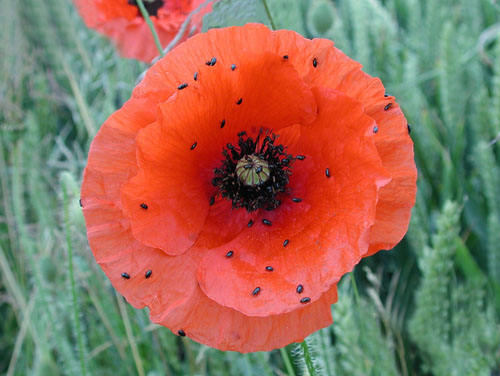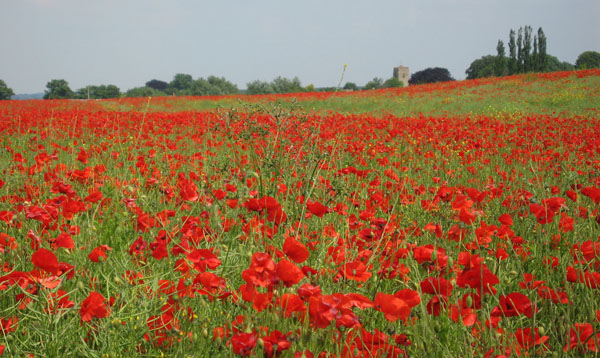
FLOWER OF THE MONTH - JUNE 2009
(Home)
COMMON or CORN POPPY (Papaver rhoeas)

This showy annual is very much a plant of arable or otherwise disturbed land:
“’Neath the blue of the sky, in the green of the corn,
It is there that the regal red poppies are born”’
as Clement Scott put it. Its precise origins are not known, but it followed the spread of agriculture across the world from the early days of civilization. Poppy seeds have been found in relics from ancient Egypt dating back well over 4000 years, and the poppy was the sacred plant of Ceres, the Roman goddess of the harvest. It was therefore a symbol of life and re-birth before it also became associated with death as a result of the slaughter on the western front in the first great world war. When the whole landscape around the trenches was being reduced to an obscene sea of mud, the poppies would spring to life and carpet the ground with their deep scarlet flowers, which came to symbolise also the spilt blood. John McRae’s famous lines are read every year at Armistice Day ceremonies:
“In Flanders fields the poppies grow
Between the crosses row on row…”
Poppy seed can remain dormant in the soil for decades, perhaps even up to 100 years, waiting for the ground to be disturbed, by plough, explosives or JCB. During the 1939-1945 war and afterwards, when food production was of overriding importance, the widespread use of herbicides largely wiped out the poppy, along with other “weeds” of arable ground, except, for example, where road works led to soil being upturned, when the seeds would take their chance to germinate. Recently, the fields left fallow under the set-aside scheme have given the poppy another opportunity to flourish, and every now and then we are surprised, and probably delighted (unless of course we are farmers) to see a sudden great blaze of red.

Poppies and Sulgrave Church from Culworth Road
When looked at more closely, the four petals of each flower have a silky texture, and when the sun shines through them they glow very brightly. The stems and pinnate leaves are roughly hairy. The Shirley poppies of our gardens, with their wide range of colours, were bred from the corn poppy during the nineteenth century.
Text by George Metcalfe. Photos by Colin Wootton.